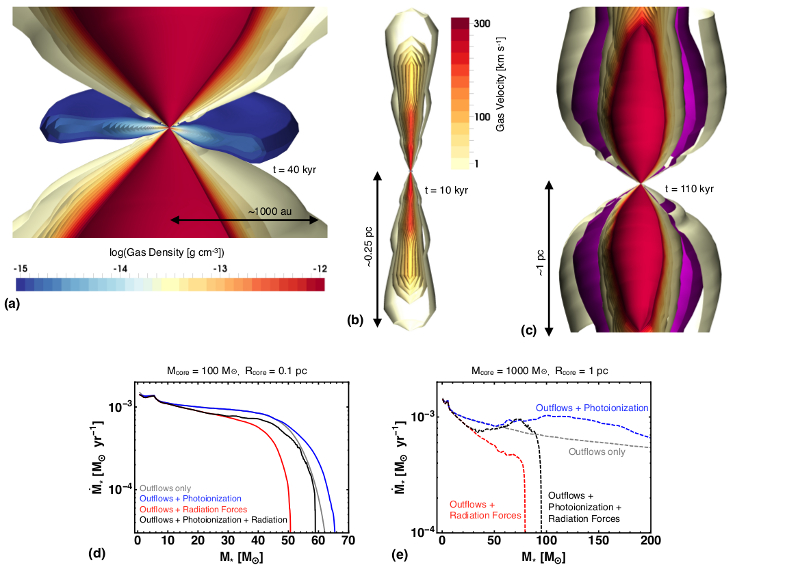| EPoS Contribution |
|
First Hydrodynamics Simulations of Radiation Forces and Photoionization Feedback in Massive Star Formation
Rolf Kuiper IAAT/U Tuebingen, Tuebingen, DE | |
| We present the first simulations of the formation and feedback of massive stars which account for radiation forces as well as photoionization feedback (along with protostellar outflows) simultaneously. We perform direct hydrodynamics simulations of the gravitational collapse of high-density mass reservoirs toward the formation of massive stars including self-gravity, stellar evolution, protostellar outflows, continuum radiation transport, photoionization, and the potential impact of ram pressure from large-scale gravitational infall. For direct comparison, we execute these simulations with and without the individual feedback components. Furthermore, each simulation series is performed starting from two different accretion scenarios, namely a finite small-scale mass reservoir such as a pre-stellar core vs. a virtually infinite reservoir which accounts for large-scale accretion flows. We determine the relative strength of the feedback components and derive the size of the reservoir from which the forming stars gained their masses. We find that protostellar outflows (see Fig. panel b) alone only limit the stellar mass growth in an accretion scenario with a finite mass reservoir (see Fig. panel d); when including accretion and ram pressure from large scales (> 0.1 pc...1 pc), protostellar outflows do not limit stellar mass growth at all (see Fig. panel e). Photoionization and HII regions dominate the feedback ladder only at later times, after the star has already contracted down to the zero-age main sequence, and only on large scales. Specifically, photoionization yields a broadening of the bipolar outflow cavities (see Fig. panel c) and a reduction of the gravitational infall momentum by about 50%, but does not limit the stellar mass accretion (see Fig. panel e). On the other hand, we find radiation forces restrain the gravitational infall toward the circumstellar disk, impact the gravito-centrifugal equilibrium at the outer edge of the disk (see Fig. panel a), and eventually shut down stellar accretion completely (see Fig. panel e). The most massive star formed in the simulations accreted 95 Msun before disk destruction; this mass was drawn-in from an accretion reservoir of about 240 Msun and about 0.24 pc in radius. Concluding, in the regime of very massive stars, the final mass of these stars is controlled by their own radiation force feedback. | |
 | |
| Caption: Upper part: 3D contour rendering of the morphologies shaping the stellar environment on different spatial scales and times of evolution: (a) the circumstellar accretion disk, (b) the bipolar protostellar outflow, and (c) the expanding HII region. The accretion disk is presented in terms of iso-density contours, the outflow in terms of iso-velocity contours. The extent of the HII region is shown as a purple iso-contour. Lower part: Stellar accretion rate in the finite mass reservoir scenario (left panel) and the extended large-scale accretion scenario (right panel) as function of the actual stellar mass for four different feedback configurations: only protostellar outflows (gray lines), protostellar outflows plus photoionization feedback (blue lines), protostellar outflows plus radiation force feedback (red lines), and protostellar outflows plus photoionization plus radiation force feedback (black lines). | |
| Collaborators: T. Hosokawa, U Kyoto, JP |
Suggested Session:
High-mass star/star cluster formation |

